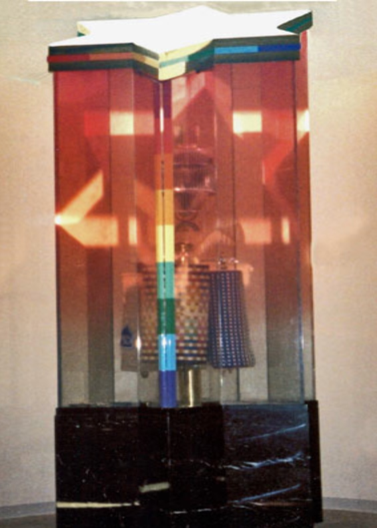Schechner defines for us “Environmental Theater,” a more comprehensive and expansive conception of theater which we will find quite helpful in application to Jewish worship:
The first…principle of environmental theater is to create and use whole spaces – literally spheres of spaces, and spaces within spaces – which contain, or envelop, or relate, or touch all the areas where the audience is and/or the performers perform. All the spaces in a theater are actively involved in all the aspects of the performance *page 2)
Written and illustrated by Yaacov Agam
From Reform Judaism, Fall 1994
Reprinted with permission.
What is the function of the synagogue, and does the architecture meet the needs of the worshipers? After considering these questions for many years, I have concluded sadly that the architectural organization of most synagogues inhibits rather than enhances the spiritual aspirations of our people.
People go to synagogue to be part of a community. That is why Jewish communal worship requires a minyan of ten or more people. The individual is only a part of a whole or unity, which in the Shema is expressed as Oneness.
It has always disturbed me that upon entering the sanctuary, you see a back view of the community. That is because the synagogue follows the old Roman or Greek theatrical concept, with a seating hierarchy: the front rows are reserved for people of means and influence, then come the regular people, followed by the poor and the slaves. Such a configuration contradicts a fundamental Jewish spiritual concept — we are all equal before God.
I also object to the placement of the Torah ark and bimah in one particular location. (The ark is placed in the direction of Jerusalem). God is everywhere and not limited to a given space. Wholeness cannot be isolated. My ideal synagogue would use architectural innovations to create a sacred space that would truly satisfy our needs.
Instead of seating people in the same direction, facing the backs of heads, I would use revolving chairs. If everyone could turn 360 degrees, they could at any time face different people, constantly creating different community groups. And, instead of appearing like an actor in front of the congregation, the rabbi could move around and between the people. Looking at our brothers and sisters, we could see ourselves as a people of shared ideals, values, and aspirations, and as a reflection of the divine spirit.
Instead of assembling all the Torah scrolls in an ark, I would place them in different locations throughout the sanctuary to express the idea that God’s glory fills the universe.
Rotating chairs could be added or removed to accommodate the exact number of worshipers present, as empty seats project a disturbing and distracting sense of missing people and emptiness.
More color could be used, as the covenant with God is sealed with a rainbow. Rainbow colors express our direct relationship with divinity and God.
The most daring innovations in technology and electronics should be employed to enhance our worship experience. The ner tamid I created for the synagogue at the Palm Springs Jewish Community Center is controlled by computer, and the ark is engineered so that the Torahs can be made to “disappear” when a non-religious activity is performed.

If we wish to encourage our children to embrace a dynamic Judaism in the 21st century, we must create the right kind of space to meet our spiritual aspiration as Jews.
This is a challenge of great urgency.